A variation of the famous Kishmish marked "Zaporizhzhya" appeared in the last century. Variety has a second the name "Kishmish Klochikova" in honor of its creator. The Ukrainian breeder took two famous varieties of Rusball and Victoria to obtain grapes. As a result of the cross, a seedless variety with very high taste qualities appeared.
Content
Characterization and description of the variety
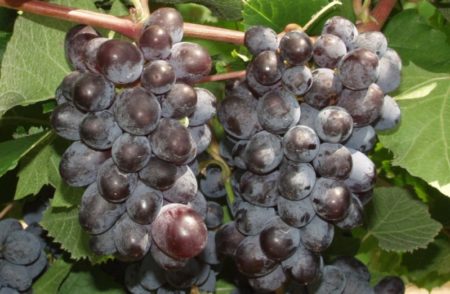 To taste Zaporizhzhya Kishmish is sweet, acid is not felt at all. The variety will surely enjoy the sweet tooth. Grapes are grown for themselves, on an industrial scale. A variety suitable for winemaking, canning. Berries grow small, weighing 2-3 g. Ripening begins at the end of summer. The growing season is from 115 to 120 days. Berries are collected in large, weighty clusters weighing more than kg. Often the weight of clusters reaches 1.5 kg. The color of the skin varies from dark purple, almost black to burgundy.
To taste Zaporizhzhya Kishmish is sweet, acid is not felt at all. The variety will surely enjoy the sweet tooth. Grapes are grown for themselves, on an industrial scale. A variety suitable for winemaking, canning. Berries grow small, weighing 2-3 g. Ripening begins at the end of summer. The growing season is from 115 to 120 days. Berries are collected in large, weighty clusters weighing more than kg. Often the weight of clusters reaches 1.5 kg. The color of the skin varies from dark purple, almost black to burgundy.
Grapes are characterized as a medium-sized variety. The vine can grow up to 5 m. The shoot formation is very active, especially in the first years after planting. Grape growers recommend doing annual pruning for 6-8 eyes. The load on the bush should be no more than 25-30 eyes for stable fruiting. Fruiting shoots of at least 80%, maturation is considered high.
Frost resistance up to -25 degrees allows you to breed Zaporizhzhya Kishmish throughout the country, including the Urals and Siberia. Excellent variety grows and propagates in the central part of Russia. Suitable for landing in the south.
The variety has good immunity to many diseases that are inherent in the grape culture. Shoots and berries are almost never affected by oidium, anthracnose, mildew. Nevertheless, the processing of Kishmish is carried out 1-2 times a season to completely eliminate the likelihood of infection.
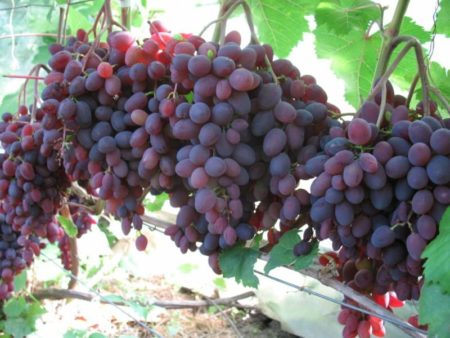 The strong qualities of Kishmish Zaporizhzhya are:
The strong qualities of Kishmish Zaporizhzhya are:
- lack of seeds in the pulp;
- the sweet taste of berries;
- beautiful appearance;
- high productivity;
- full ripening of shoots;
- frost resistance;
- strong immune abilities.
Kishmish has flaws. It:
- abundant education of stepsons;
- poor separation of the clusters from the stalk.
In the summer, wasps often attack grapes during flowering and fruiting. To scare away insects, set in the area of the trap, and before flowering, the vineyards are treated with insecticidal preparations.
Landing
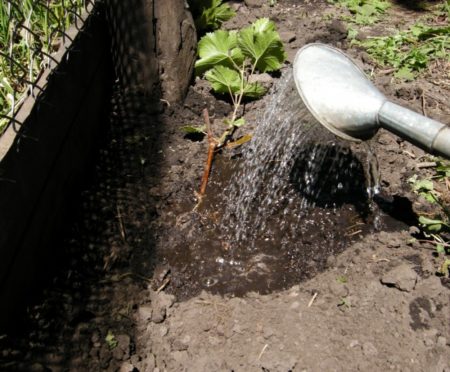 Kishmish Zaporizhzhya saplings are sold at exhibitions and fairs. Saplings are purchased in spring or autumn, grapes can be planted at any time, except winter. The landing site should be located on a plain or hillock, the groundwater level should not be closer than 1.5 m from the ground. Kishmish grows well in neutral and slightly acidic soil. The soil must be porous.
Kishmish Zaporizhzhya saplings are sold at exhibitions and fairs. Saplings are purchased in spring or autumn, grapes can be planted at any time, except winter. The landing site should be located on a plain or hillock, the groundwater level should not be closer than 1.5 m from the ground. Kishmish grows well in neutral and slightly acidic soil. The soil must be porous.
Grapes are planted with warming, when there will definitely be no frost. Dig a hole with a depth of at least 70-80 mm, and drainage with a height of at least 20 cm is laid at the bottom.
Then the soil mixture is fertilized with peat with humus in a ratio of 1: 1. About 10-15 kg of fertilizer is enough for one hole. When laying the soil, it is necessary to sprinkle superphosphate and potassium sulfate 30-50 g per well in peat. The sapling is inserted into the ground, straightened roots and instilled with the ground. A support is placed next to the seedling. The ground near the trunk is rammed with hands and watered the plant with cool water. After watering, you can mulch the ground with sawdust.
Care
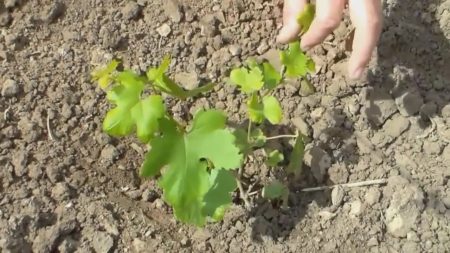
Watering for grapes is important, but should not be frequent. From the moment of budding up to the end of fruiting, the grapes are watered only 3-4 times. Refrain from watering when the plant is in bloom or bears fruit. Watering at this time is very risky: it can contribute to a deterioration in the taste characteristics of berries and their reduction. Often growers use the drip method of irrigation, especially if there are a lot of bushes on the site. Such a system is convenient and practical to use, the consumption is minimal, and water flows directly to the roots.
It is better to refuse feeding at the beginning of cultivation. If the soil was fertilized during planting, then within 2-3 years the roots have enough nutrients, and their excess will only cause damage to the culture. In the future, fertilizers should be applied with mineral fertilizers, balanced complexes for growing grapes, organic additives. Top dressing is usually applied before budding, during flowering and before fruiting.
Shelter for the winter
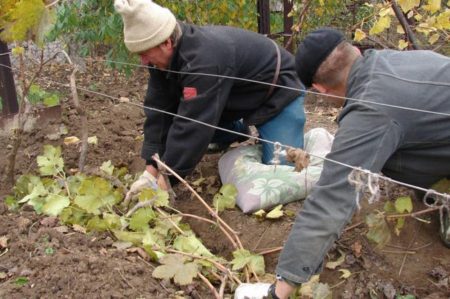 Young grapes are especially sensitive to temperature differences, so they cover it first of all. At the end of October, the vine is cut, treated with copper sulfate so that the plants do not become infected with diseases during the winter, and the soil is well watered. When the earth dries up, they begin to shelter the culture. This can be done in two ways:
Young grapes are especially sensitive to temperature differences, so they cover it first of all. At the end of October, the vine is cut, treated with copper sulfate so that the plants do not become infected with diseases during the winter, and the soil is well watered. When the earth dries up, they begin to shelter the culture. This can be done in two ways:
- in a dry way. They close the vineyards with agrofibre, wooden boxes, bags, films and other heat-holding materials. They lay the vine on the ground and build a tunnel under it from rods or metal boxes. The material is pulled onto the metal. It should be a greenhouse in which the grapes are successfully wintered;
- digging vines into the ground. The vine is put on the ground and dug up with soil taken from the row-spacing with a layer of 10-20 cm. Cellophane is put on top so that the ground is not wet.
Both methods are quite acceptable, so you need to choose one or another method based on the climatic characteristics of the region. So the first method is more suitable for sheltering Kishmish in the northern regions, and you can dig a vine for the winter in the central part of Russia.
Reviews
Oleg from the Krasnodar Territory
Zaporizhzhya raisins are famous not only for resistance to sores and frosts, but also for drought. The summer turned out to be hot, but the berries did not lose sugar, and their appearance did not change. Wasps did not attack grapes, did not process anything. The berries appeared by the middle of summer, they liked the taste and quality. Some of the fruits were dried. After harvesting, I always dip the berries for a couple of seconds in a soda solution (1 tablespoon per liter of water) to wash off the spring. Washed grapes have a beautiful glossy gloss and look more appetizing.
Sergey from Dnepropetrovsk
The berries are sweet, but prone to cracking. In the third year of harvest, the berries began to burst right on the branches. It did not work to harvest, basically, everyone ate it so that the berries did not spoil. Perhaps it happened because of an excess of watering (watered 2-3 times a month) or because of rainy weather.




 Non-covering winter-hardy grape varieties for Moscow region
Non-covering winter-hardy grape varieties for Moscow region How to keep the vine in winter
How to keep the vine in winter When can I transfer grapes to another place in the fall
When can I transfer grapes to another place in the fall How to cover and prepare grapes for the winter in the suburbs
How to cover and prepare grapes for the winter in the suburbs